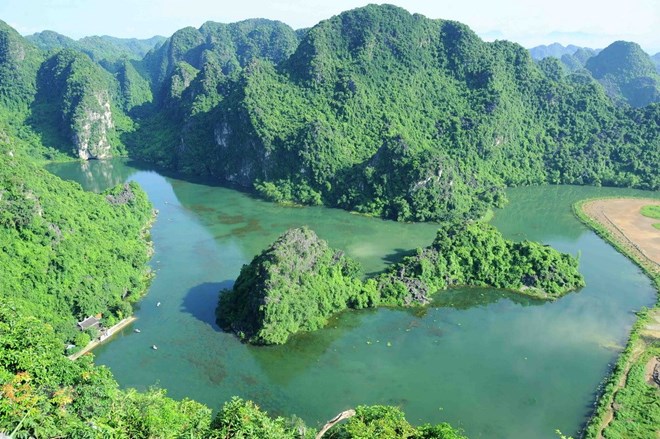



Tran An complex is known as "Ha Long Bay on Land”(Photo: VNA)
Throughout the event, Ninh Binh wanted to connect with tourism
firms in Khanh Hoa to attract more travellers to the locality and vice versa.
It expects to learn experience from Khanh Hoa in organising the Visit Vietnam
Year 2019 as Ninh Binh will host the event in 2020.
Local excellent tourism products and policies to attract investment in the
field were introduced at the event. Besides renowned destinations like Tam
Coc-Bich Dong, Trang An Landscape Complex – a world cultural and natural
heritage, Hoa Lu ancient capital and Bai Dinh Pagoda, the province is working
to develop alluring tourism packages.
Representatives from tourism firms suggested measures for Ninh Binh province to
extend visitors’ stay in the locality with a view to increasing tourism
revenue. Local tourism sector should improve quality of accommodation and
services while developing more night entertainment activities.
Located about 90 kilometres south of Hanoi, Ninh Binh is known as "Ha Long Bay
on Land”, given its limestone mountains rising out of paddy fields. The most
famous local attraction is the Trang An Landscape Complex with a total of 40
tourism spots of historical, cultural, art and natural vestiges, including 20
recognised as national heritages.
In UNESCO’s words, "Trang An is a resplendent complex of limestone karst
peaks which are permeated with valleys, including submerged ones, and
surrounded by steep, almost vertical cliffs".
Together with other famous sites in the province such as Tam Coc Grottos and
Van Long Lagoon, the Trang An Landscape Complex was also used as a location for
the movie Kong: Skull Island, one of the biggest Hollywood blockbusters of
2017. The locations opened to tourists last April.
The province has been listed as one of the 50 best spots to visit in 2018 by US
travel site Insider.
Ninh Binh is striving to become one of the tourism hubs of Vietnam by 2020 and
to turn tourism into a spearhead industry of the local economy by 2030. This is
the goal of the province’s master plan on tourism development until 2025, with
a vision to 2030.
Ninh Binh looks to attract 1 million foreign arrivals and 7 million domestic
visitors by 2020, 1.5 million and 9 million by 2025, and 2.1 million and 11.2
million by 2030. Meanwhile, tourism revenue is expected at over 4.2 trillion
VND (179.7 million USD), 11.8 trillion VND (504.8 million USD), and 27 trillion
VND (1.15 billion USD), respectively.
Under the plan, the province will turn Ninh Binh city into the main tourism
centre while Tam Diep city and townships in Hoa Lu, Gia Vien, Nho Quan, Yen Mo,
Yen Khanh and Kim Son districts will be developed into supporting centres.
The Trang An Landscape Complex and the Kenh Ga – Van Trinh national tourist
area will continue to be improved to deserve their national status. Six
provincial tourist areas and more places of interest will also be formed in the
coming years.
To realise this plan, Ninh Binh is set to ask for the Government and relevant
ministries’ permission to apply some special preferential policies to attract
investment to tourism.
Provincial authorities also called on the Ministry of Culture, Sports and
Tourism to further include local tourism information in promotion programmes
for Vietnamese tourism and support Ninh Binh in training human resources,
expanding markets and products, and protecting the environment.
According to the provincial Department of Tourism, Ninh Binh welcomed more than
7 million visitors and earned over 2.5 trillion VND (107 million USD) from this
industry in 2017, respectively rising by 9.5 percent and 43 percent year on
year.
In the last eight months, over 6 million vacationers chose Ninh Binh as their
destination, helping the province gain 2.3 trillion VND (98.4 million USD) in
tourism revenue, up 5 percent and 18.8 percent from the same period last year,
respectively.
Source: VNA